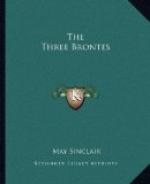There was no fine madness in that method; but its very soundness and sanity show the admirable spirit in which Charlotte Bronte approached her art. She was to return to the method of The Professor again and yet again, when she suspected herself of having given imagination too loose a rein. The remarkable thing was that she should have begun with it.
And in some respects The Professor is more finished, better constructed than any of her later books. There is virtue in its extreme sobriety. Nothing could be more delicate and firm than the drawing of Frances Henri; nothing in its grey style more admirable than the scene where Crimsworth, having found Frances in the cemetery, takes her to her home in the Rue Notre Dame aux Neiges.
“Stepping over a little mat of green wool, I found myself in a small room with a painted floor and a square of green carpet in the middle; the articles of furniture were few, but all bright and exquisitely clean—order reigned through its narrow limits—such order as it suited my punctilious soul to behold.... Poor the place might be; poor truly it was, but its neatness was better than elegance, and had but a bright little fire shone on that clean hearth, I should have deemed it more attractive than a palace. No fire was there, however, and no fuel laid ready to light; the lace-mender was unable to allow herself that indulgence.... Frances went into an inner room to take off her bonnet, and she came out a model of frugal neatness, with her well-fitting black stuff dress, so accurately defining her elegant bust and taper waist, with her spotless white collar turned back from a fair and shapely neck, with her plenteous brown hair arranged in smooth bands on her temples and in a large Grecian plait behind: ornaments she had none—neither brooch, ring, nor ribbon; she did well enough without them—perfection of fit, proportion of form, grace of carriage, agreeably supplied their place.” Frances lights a fire, having fetched wood and coal in a basket.
“‘It is her whole stock, and she will exhaust it out of hospitality,’ thought I.
“‘What are you going to do?’ I asked: ’not surely to light a fire this hot evening? I shall be smothered.’
“’Indeed, Monsieur, I feel it very chilly since the rain began; besides, I must boil the water for my tea, for I take tea on Sundays; you will be obliged to bear the heat.’”
And Frances makes the tea, and sets the table, and brings out her pistolets, and offers them to Monsieur, and it is all very simple and idyllic. So is the scene where Crimsworth, without our knowing exactly how he does it, declares himself to Frances. The dialogue is half in French, and does not lend itself to quotation, but it compares very favourably with the more daring comedy of courtship in Jane Eyre. Frances is delicious in her very solidity, her absence of abandonment. She refuses flatly to give up her teaching at Crimsworth’s desire, Crimsworth, who will have six thousand francs a year.




